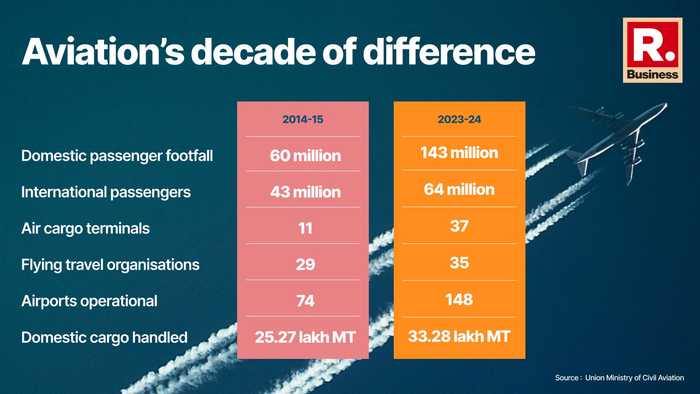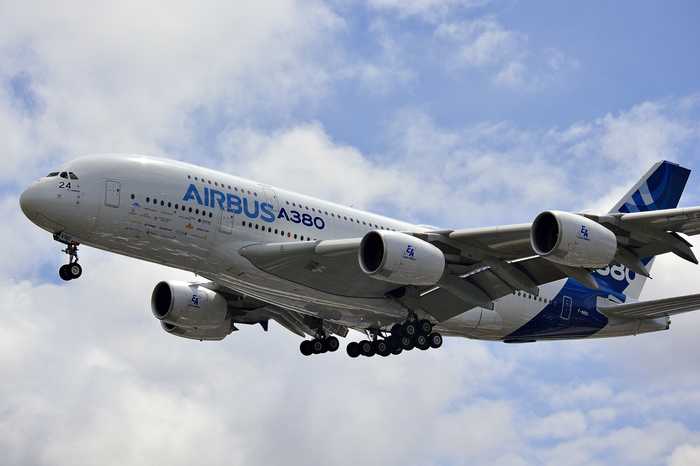Published 19:35 IST, February 26th 2024
After India’s open sky policy for international cargo airlines, the chorus is growing for foray of more international airlines.
Advertisement
Aviation push: India’s open sky policy, that allows foreign air cargo carriers to operate out of all airports across India, recently got a lease of life. The Union Civil Aviation Ministry, last week renewed India’s open sky policy for foreign cargo airlines. In 2020, the Ministry had restricted foreign cargo airline operations to just six airports across the country.
The open sky policy amendment comes as a shot in the arm for India’s capacity to handle international cargo, which was up at 15.29 lakh metric tonnes (MT) in 2022-23, witnessing a 7.5 per cent YoY growth. In the passenger air travel segment too, India has witnessed an uptick. Domestic air traffic in January this year stood at 13.12 million passengers, almost 4.7 per cent YoY growth. With a post-Covid recovery, air travel in India, as per aviation body CAPA is projected to witness 10-20 per cent growth in the next one year. Will the open sky policy fulfill India’s air travel demand? Republic Business takes a deep dive.
Advertisement

New aircraft, airfares
Projections charting the trajectory of India’s aviation sector, expect the addition of 3,500 new aircraft by 2047. Airlines at present have placed confirmed 1,500 aircraft orders, for strengthening the existing fleet of 810 aircraft, as per a KPMG and FICCI's report.
Advertisement
Subhash Goyal, Chairman, Aviation and Tourism, Indian Chamber of Commerce told Republic Business that an increase of nearly 2,700 aircraft, over 24 years, with a 6 per cent growth rate is expected to help in connecting the country's smaller centers with their larger peers.
“Of the total 3,500 new aircraft, Indian carriers are expected to induct 2,700 aircraft for their domestic operations, while the remaining 860 aircraft are expected to be pressed for international flights,” said Goyal, adding that engine troubles and costly aviation turbine fuel have been a cause of concern for airlines globally, also taking a toll on India’s airlines.
Advertisement
“Delhi and Toronto airfares earlier between Rs 60,000 - Rs 70,000 have now shot up to Rs 1.5 lakh. Skyrocketing of airfares needs to be curtailed and if the government is putting a capping on the taxi fares of tourists going from the airport to the hotels, then I think there is no harm in putting an upper limit if the direct operating cost of an airline is Rs 4,000 between Delhi and Mumbai,” said Goyal, adding that a maximum airfare capping of Rs10,000 to Rs 20,000 can be made effective.
"There has to be an upper limit so that the consumer is not exploited by the airlines,” the veteran aviation expert said.
Advertisement
Foreign airlines foray
With a surge in leisure tours, corporate travel, and a boost in medical tourism, the country is set to see growth in air travel. A confirmed order for 1,500 aircraft by India’s airlines, and foray of international players in India's aviation will set the ball rolling.

Image credit: Unsplash
Advertisement
“Despite all the aircraft orders, a lot of international airlines that want to come into India are not able to make a foray. I urge the government to have an open sky so that the supply of aircraft is increased and the airfares which have skyrocketed after COVID would come down. Otherwise, the government will be forced to put a ceiling on the upper limit of the airfares,” Goyal further said.
Airport upgradation
Airports Council International’s latest rankings of airports in India, in its airport customer experience measurement, Airport Service Quality assessment for Q3 FY24, has highlighted loopholes related to passenger handling at several of the airports, especially in terms of airport terminal infrastructure.
Apart from the focus on greenfield and brownfield airports, the expansion of existing airport terminals, experts say, will help in catering to the growing passenger demand. Upgradation of airport runways in the northern parts of the country, to minimise weather-related cancellations is also a key focus area for India’s aviation is a need of the hours, says Goyal, a veteran tourism industry leader.
19:35 IST, February 26th 2024